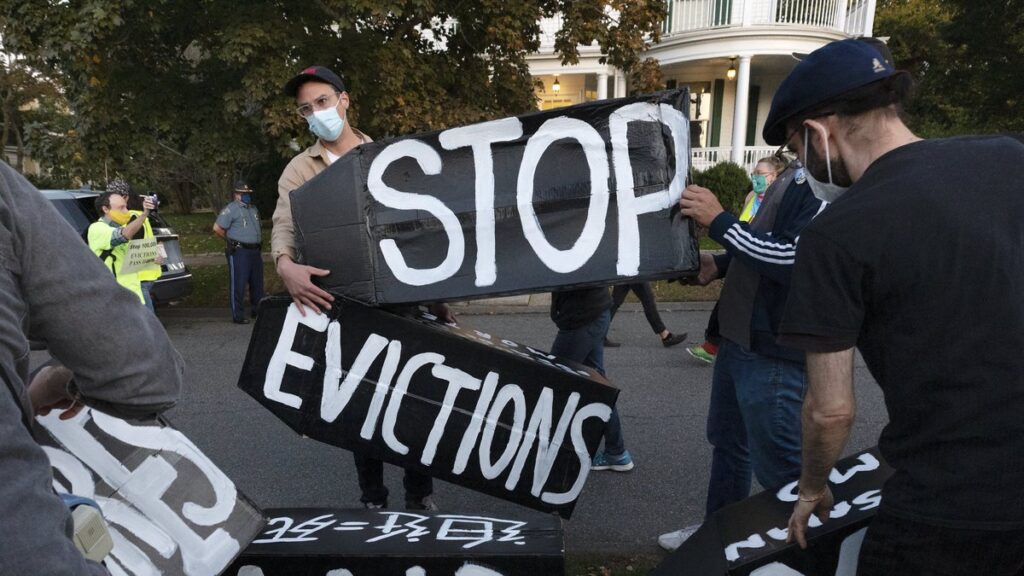FILE – In this Oct. 14, 2020, file photo, housing activists erect a sign in Swampscott, Mass. A federal freeze on most evictions is set to expire soon. The moratorium, put in place by the Centers for Disease Control and Prevention in September, was the only tool keeping millions of tenants in their homes. (AP Photo/Michael Dwyer, File)
SALT LAKE CITY (AP) — A federal freeze on most evictions enacted last year is scheduled to expire Saturday, after the Biden administration extended the original date by a month. The moratorium, put in place by the U.S. Centers for Disease Control and Prevention in September, was the only tool keeping millions of tenants in their homes. Many of them lost jobs during the coronavirus pandemic and had fallen months behind on their rent.
Landlords successfully challenged the order in court, arguing they also had bills to pay. They pointed out that tenants could access nearly $47 billion in federal money set aside to help pay rents and related expenses.
Advocates for tenants said the distribution of the money had been slow and that more time was needed to distribute it and repay landlords. Without an extension, they feared a spike in evictions and lawsuits seeking to boot out tenants who were behind on their rents.
Even with the delay, roughly 3.6 million people in the U.S. as of July 5 said they face eviction in the next two months, according to the U.S. Census Bureau’s Household Pulse Survey. The survey measures the social and economic effects of the coronavirus pandemic every two weeks through online responses from a representative sample of U.S. households.
Here’s the situation in Utah:
WHAT’S THE STATUS OF EVICTION MORATORIUMS IN THE STATE?
Utah’s eviction moratorium has long since expired, leaving only the CDC moratorium, though hundreds of people have still been evicted over the past year for reasons other than an inability to pay. The U.S. Census estimates that nearly 2,200 people in Utah are at high risk of eviction and foreclosure as the CDC moratorium ends, and almost 9,600 are at some risk of losing housing.
A tight housing market in Utah only got tighter during the pandemic, and rent prices kept growing too. The average rent for a two-bedroom apartment is now $1,350, a 4% increase compared with the previous year, according to a July report from the rental site Zumper.
In order to afford a modest, two-bedroom apartment in Utah, full-time workers need to earn $20.21 per hour, according to a recent report from the Utah Housing Coalition. The minimum wage in Utah is $7.25 an hour, and the median renter wage is $15.66.
WHAT’S BEING DONE TO HELP PEOPLE FACING EVICTION?
Utah still has about $150 million in federal funding to help tenants with outstanding rent, utility payments and other expenses, though. The state had paid out $41 million in rental assistance by the end of July, according to the state Department of Workforce Services.
The money can go toward rent and other expenses, like utilities and past-due rent. Renters who make 80% of the area’s median income and have financial hardship or instability because of COVID qualify. There is some assistance available not related to COVID. Landlords can also apply on behalf of their tenants.
People who need help paying rent can apply for emergency assistance at rentrelief.utah.gov.
ARE EVICTIONS EXPECTED TO CREATE A SURGE IN HOMELESSNESS?
The state has already seen a bump in homelessness in 2021, and the end of the moratorium is expected to touch off another increase, Francisca Blanc, advocacy and outreach coordinator with the Utah Housing Coalition, has said. Meanwhile, a provision of Utah law that allows landlords to collect triple the daily rent if a tenant overstays the three-day window they have to vacate a property has other advocates worried about a surge in bankruptcy filings and debt collections.

